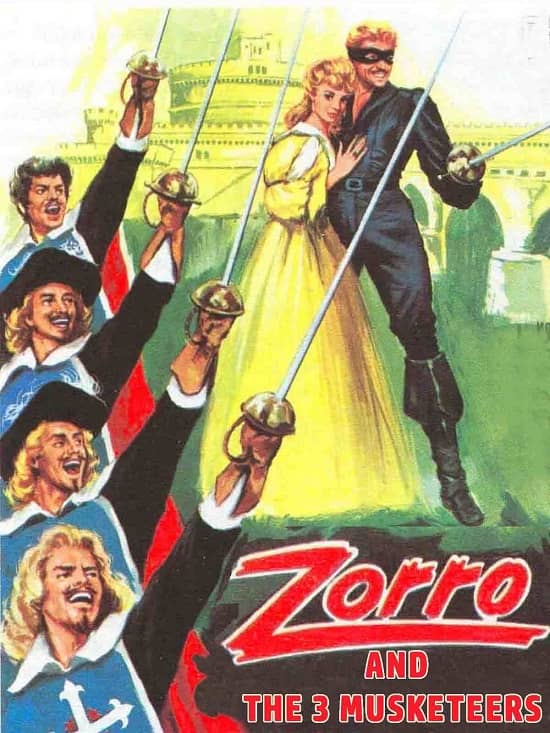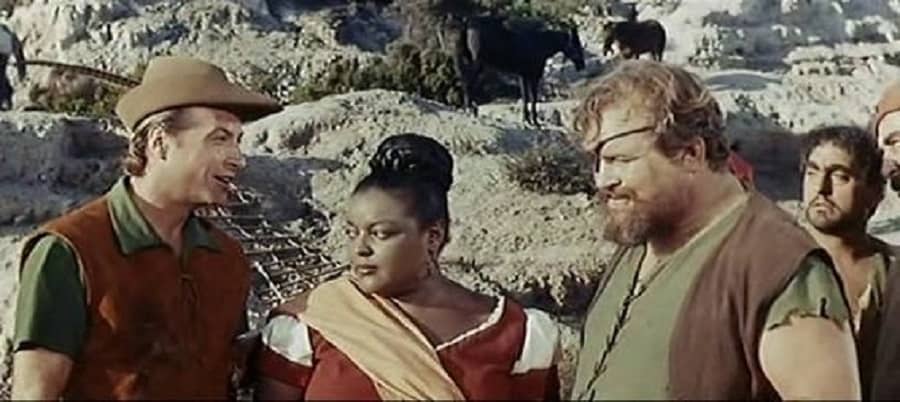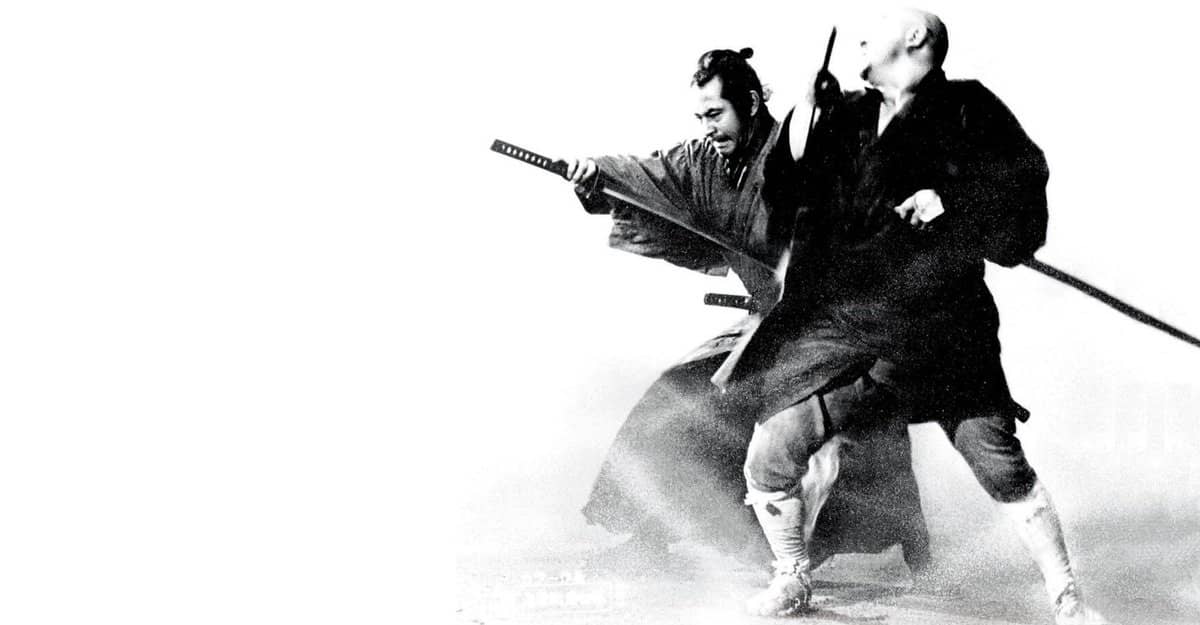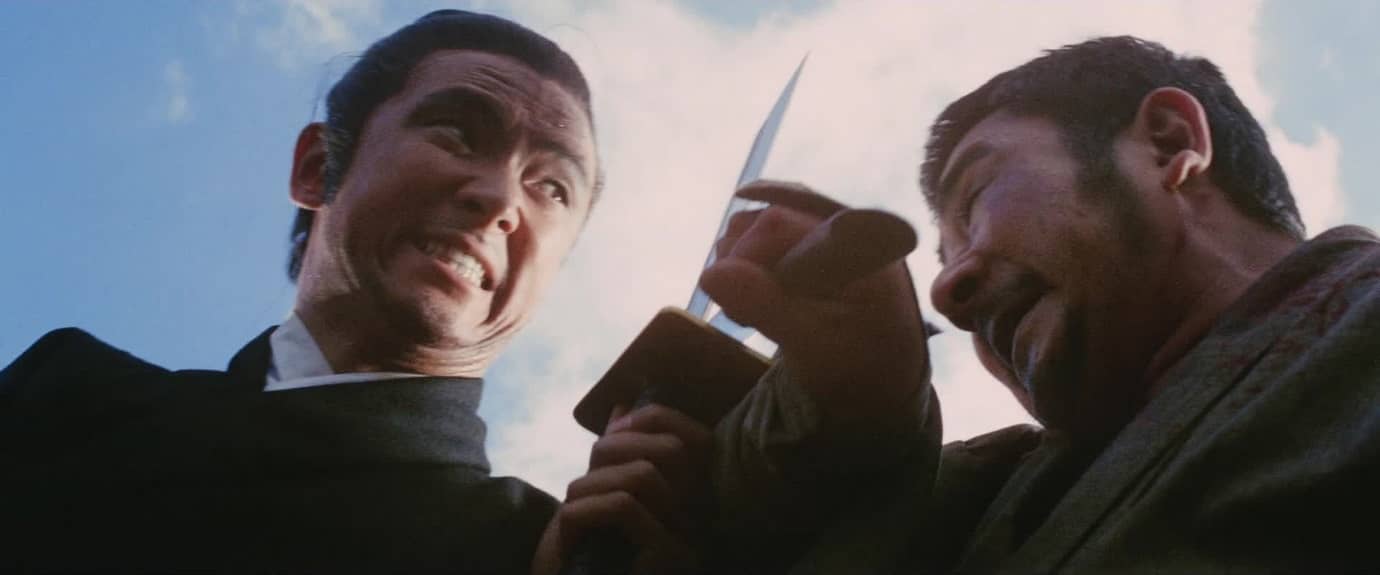Ellsworth’s Cinema of Swords: Mash-Up or Shut Up
Zorro and the Three Musketeers (Italy, 1963)
Everyone likes crossovers and mash-ups, right? If you’re a fan of two heroes in the same genre, then of course you’d like to see a story in which they meet and confront a challenge together. That is the commercial calculation for crossovers in every medium, whether it’s comics, games, TV shows, or movies. It’s assumed a crossover or mash-up is a sure thing that will draw in the fans of both franchises. It’s a no-brainer.
In principle, maybe, but not in practice. In practice, the story or personality elements that create the appeal of one character don’t always fit comfortably with the elements of another. Zorro and the Three Musketeers, for example: all cheerful swashbucklers, but the musketeers are a disparate bunch that rely on teamwork, while Zorro is fundamentally a loner, so mashing them together in a coherent and credible plot is a task that shouldn’t be underestimated, calling for a top-notch screenwriter. Or what if you put together two characters like Yojimbo and Zatoichi, each of whom usually functions as the fulcrum of the plot? What do you do with two fulcrums? Solving these problems can be a high bar to get over, and sometimes a low-budget genre picture just isn’t up to it.
Though one has to admit, Zatoichi Meets the One-Armed Swordsman actually pulls it off.
Zorro and the Three Musketeers
Rating: **
Origin: Italy, 1963
Director: Luigi Capuano
Source: Amazon Streaming Video
There are many fine swashbuckling comedies. This isn’t one of them.
Through the narrative magic of simply ignoring everything ever established about his origin and background, Zorro is whisked back two centuries to the 1600s. France and Spain are at war, with the Four Musketeers on the side of the French and Zorro intriguing for Spain, but even though they’re on opposite sides they manage to become the best of frenemies because that Zorro guy is just so darned smart. Along the way we’re given the musketeers in gratuitous, slapstick bar fights, their four lackeys clowning around with Zorro’s lackey, and Gordon Scott fopping away at the Court of Spain waving a limp handkerchief because he’s actually Zorro, and when he wears a mask he’s wanted for acts of Zorro-ness.
It’s a shame the jokes aren’t funny because the story itself is actually pretty clever. It manages to get Zorro into France to rescue a Spanish lady, Doña Isabella (José Greci), whom the Four Musketeers have been ordered by Cardinal Richelieu to guard. Zorro pulls a fast one on the Cardinal, the Cardinal’s Guard, and all four musketeers and gets Isabella across the border into Spain, but not before she falls in love with her rescuer. However, d’Artagnan and Co. then have to go to Madrid to try to kidnap her back or they’ll get sent to the Bastille. Naturally, there’s one big villain all the heroes can fight, a treacherous Spanish count who wants Isabella for himself, and Zorro and the musketeers must join forces to bring him down.
Gordon Scott (an ex-Tarzan) actually makes a decent Zorro, and he fences well into the bargain, but the musketeers are pretty weak, entirely interchangeable except for Porthos, played by peplum stalwart Livio Lorenzon, who always exudes character even when he isn’t given one to portray. Otherwise, the musketeers just laugh, and drink, and laugh, and fight, and laugh, and it gets pretty tiresome. To be fair, there isn’t much else for them to do because the budget for this film was about twelve dollars, a constraint most evident in the execution scene, where a cast of tens mills around a scaffold in a square in “Madrid” that’s about the size of a suburban backyard. I’ve had more people over for a barbecue. This movie is hard to find, but that’s okay: some things are better left unfound.
Robin Hood and the Pirates
Rating: *
Origin: Italy, 1960
Director: Giorgio Simonelli
Source: Amazon streaming video
The first major Robin Hood feature film was the Douglas Fairbanks vehicle of 1922, and over the next forty years there were at least a dozen more. Robin Hood and the Pirates is a leading contender for the worst of the lot. In the late 1950s, Lex Barker, a handsome but bland American leading man (Tarzan, Westerns) found his star setting in Hollywood, so he went to Europe where he made a half-dozen or so low-budget swashbucklers. Some of these films eventually got dubbed into English for the American drive-in market, but many never made it back over the pond—Barker spoke Spanish, French, and Italian, so the films didn’t need to be shot in English. But they’re nearly all terrible, so this is no great loss unless you’re a swashbuckler completist like Your Editor.
Robin Hood is on his way to the Crusades in the 12th century when he gets captured by pirates from the 18th century and is held for ransom. There’s a storm and the pirates’ ship wrecks (offscreen, because shipwrecks are expensive to film), and Robin washes up on the shore of the County of Sherwood. There are no forests to be seen, and the terrain looks more like Sicily, but hey—he’s home at last! However, his father’s domain, Sherwood Castle, has been taken over by a seeming 16th-century Florentine whose name, unaccountably, is Brooks, so Robin has to team up with the castaway pirates to overthrow the usurper.
That’s it: that’s the whole story. Oh, there’s an evil hunchbacked jester named Goliath, and the good dark-haired lady and the bad fair-haired lady have a catfight in a mud wallow, but those are just grace notes. The one thing that differentiates this feature from an overlong episode of a weak 1960 TV show is that four of the pirates are black African women, escaped slaves, and they’re feistier and have more fun than the rest of the lackluster crew put together. Also, there’s an implied romantic relationship between the leading black woman and the white Captain One-Eye (clever name, eh?), which is certainly something you wouldn’t see in an American picture from 1960. But otherwise, bleah.
Zatoichi Meets Yojimbo
Rating: ***
Origin: Japan, 1970
Director: Kihachi Okamoto
Source: Criterion Blu-ray
Take the two leading chambara stars of their day portraying their signature characters, Shintaro Katsu as Zatoichi and Toshiro Mifune as the nameless “yojimbo,” add in top-notch director Kihachi Okamoto (Sword of Doom, Kill!), and the result should be a sure thing. Alas, instead we get one of the weakest films in the Zatoichi series.
Zatoichi, wandering and caught in a downpour, has to defend himself against a bandit gang who are preying on refugees. “Blood on my hands again,” he complains. “I’m going home.” Ichi returns to his home village, which he remembers as a pleasant heaven, but in the years since he left it the place has become a dusty hell. Brutal gangsters have moved in and taken over, and even Ichi’s childhood sweetheart Umeno (Ayako Wakao) now works as a prostitute. Though hardened and bitter, she seems to have feelings for the drunken samurai bodyguard (Mifune) who hangs out in her tavern. The yojimbo has been hired by the town’s yakuza boss, Masagoro (Masakane Yonekura) to strong-arm his own father, businessman Eboshiya (Osamu Takizawa), into revealing where he’s hidden a cache of stolen gold. Ichi runs afoul of Masagoro, takes up with Eboshiya, and soon he and the yojimbo find themselves on opposite sides.
That may sound clear on paper, but it isn’t on film, as the introduction of all these people is slow and their motivations are murky. There are almost no sympathetic characters here, for once both Katsu and Mifune are short on charm, and “everyone is corrupt” as a theme doesn’t provide enough contrast and drive to get a plot moving. Even the harmless old ex-headman Hyoroku (Kanjuro Arashi) is expiating the sin of having invited the yakuza into town during a drought to defend it against starving refugees, carving a statue of the Buddha for every refugee who was murdered. Jolly stuff.
This movie is also too long, but in the final third it finally pulls itself together and becomes pretty good. Two more characters come to town: Eboshiya’s other son, Sanaemon (Toshiyuki Hosokawa), also corrupt, followed by a fearsome hitman from Edo named Kuzuryu (Shin Kishida). The yojimbo, whom Kuzuryu calls “Sasa,” had worked with the hitman in the past, and it turns out they are both in the village on secret orders. Sasa and Zatoichi come to a sort of entente of mutual respect, calling each other “monster” and “beast,” but Kuzuryu upsets the fragile balance and soon the swords are out. Everybody is after the hidden gold, and once our canny Ichi deduces where it is, there’s nothing left but slaughter. Umeno, the only thing both Ichi and the yojimbo hold dear, gets caught in the crossfire, and a face-off between the two is inevitable. But when top-grossing franchise characters have a showdown, is anyone really in danger?
Mifune would play his yojimbo character for the fourth and final time later in the year in Ambush at Blood Pass, which also costars Katsu. It’s a much better movie.
Zatoichi Meets the One-Armed Swordsman
Rating: ****
Origin: Japan, 1971
Director: Kimiyoshi Yasuda/Hsu Tseng Hung
Source: Criterion Blu-ray
Mash-up, chambara + wuxia! The two most popular series characters in historical Asian swordplay in 1970 face off, mainly because neither can understand what the other is saying. It’s one misunderstanding after another from beginning to end, which is actually the point of the whole thing.
A movie pitting Jimmy Wang Yu’s Wang Kang, the one-armed swordsman, against Shintaro Katsu’s Zatoichi could have been an exploitation quickie, but instead this is a serious entry in the Zatoichi series. It’s ably directed by Kimiyoshi Yasuda, who’d directed four previous films in the series including the excellent Cane Sword, with Wang Kang’s combat sequences arranged by Hong Kong director Hsu Tseng Hung.
Wang Kang comes to Japan seeking the fellowship of other martial artists at the Fukuryuji Temple, but he doesn’t speak Japanese, so he’s delighted to make the acquaintance of two traveling Chinese entertainers who speak both languages, as does their young son, Xiaorong. On the road, the four Chinese bow obsequiously before a procession of samurai of the Nanbu clan, but Xiaorong, chasing his kite, runs in front of them and the samurai draw their katanas to kill the child for this offense against propriety. Wang Kang wades in to protect him and there’s a wild mêlée that ends up with the samurai slaughtering all witnesses to cover up their overreaction. Xiaorong and his wounded father escape while Wang Kang holds off the furious samurai.
Meanwhile, Zatoichi, being pursued by goons from yet another vengeful yakuza boss, stumbles across Xiaorong and his dying father, who asks Ichi to take care of the boy. Ichi, of course, cannot refuse a dying request, and takes the child into a town, where he hears about a mad Chinese man who attacked the Nanbu clan and killed a bunch of innocents. Ichi and Wang Kang, both fugitives, encounter each other warily when they both try to use the same shack as a hideout, but Xiaorong translates for them and soon Ichi gets the real story.
But there are more misunderstandings ahead. Tobei (Toru Abe), another yakuza boss, is in the pay of the Nanbu, and his thugs are looking for both fugitives. Ichi and Wang Kang find an ally in Oyone (Michie Terada), who seems to care for Xiaorong and maybe Wang Kang, but when her family are attacked by the yakuza and Wang and the boy barely escape, the one-armed swordsman thinks Ichi sold him out. And indeed, Wang Kang runs into plenty of betrayal, including that of Kakuzen (Koji Nanbara), the martial arts monk who’d invited him to Japan, but Ichi stays true to protecting Wang and the boy.
The combat scenes of the one-armed swordsman facing the Nanbu are fascinating because the samurai don’t know what to make of him: Wang Kang leaps over their heads, runs across their shoulders, and mixes swordplay with kung fu in a manner that baffles his opponents. Only Zatoichi, who can’t see these wuxia antics, is a match for Wang Kang. Who wins their final face-off? Hint: this is Jimmy Wang’s last one-armed swordsman movie in the original series, and there are more Zatoichi films to come.
(The film reviewed here is the version made for the Japanese market. There is said to have been a variant version made for the Chinese market that has more wuxia combat and a different ending, but that version hasn’t been seen since the film’s original theatrical release. Dang it.)
Where can I watch these movies? I’m glad you asked! Many movies and TV shows are available on disk in DVD or Blu-ray formats, but nowadays we live in a new world of streaming services, more every month it seems. However, it can be hard to find what content will stream in your location, since the market is evolving and global services are a patchwork quilt of rights and availability. I recommend JustWatch.com, a search engine that scans streaming services to find the title of your choice. Give it a try. And if you have a better alternative, let us know.
Previous installments in the Cinema of Swords include:
Zatoichi’s Finest
A Little History
Lone Wolf and Cub, Part I
Premium Peplum
The Book Was Better
Shogunate’s End
Peak Musketeers
Lone Wolf and Cub, Part 2
Arthur, King of the Britons
Sinbads Three
Premium Peplum: Top Hercs
Fight Direction by William Hobbs
LAWRENCE ELLSWORTH is deep in his current mega-project, editing and translating new, contemporary English editions of all the works in Alexandre Dumas’s Musketeers Cycle, with the fifth volume, Between Two Kings, coming in July from Pegasus Books in the US and UK. His website is Swashbucklingadventure.net.
Ellsworth’s secret identity is game designer LAWRENCE SCHICK, who’s been designing role-playing games since the 1970s. He now lives in Dublin, Ireland, where he’s writing Dungeons & Dragons scenarios for Larian Studios’ Baldur’s Gate 3.




I wonder if there is a Chinese version of Zatoichi vs. The Lone Swordsman. It may be a myth like the alternate ending of Godzilla vs. King Kong where Godzilla wins.
“Only Zatoichi, who can’t see these wuxia antics, is a match for Wang Kang.”
The reviews were great, as usual, but it’s genre-wise and knowing sentences like this that add that extra savor. I understand these posts are going to be compiled into a book? I’m good for a copy.
Thanks! The Cinema of Swords will be published by Applause Books sometime in 2023 – more details as they become available.
Great news! These reviews have been a lot of fun.
Another Ellsworth’s Cinema of Swords? With a BOOK in the works? Huzzah!
Of these four, I have only seen Zatoichi vs Yojimbo (Ambush at Blood Pass IS better) but I’ve heard of Robin Hood & the Pirates (“a great movie to get drunk to”). I’ll give those first two a pass, but Zatoichi meets the One Armed Swordsman is on my To See list. Thanks for warning us about those first two films; I appreciate you taking two for the team.
*Sign me up for that book. These posts of yours are great fun!
Thank you, Mr. Ellsworth.